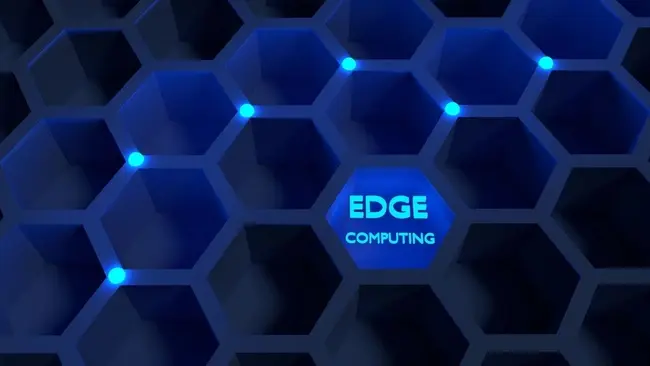In the era of digital transformation, data is at the heart of innovation. But as today’s innovators rely on huge amounts of data for critical decision-making, the need for faster and more efficient data processing has never been more apparent.
Edge computing optimises Internet devices and web applications by bringing computing closer to the source of the data. This minimises the need for long-distance communications between client and server, which reduces latency and bandwidth usage.
Sounds great, right? But what is even edge computing, and how does it work? In this article, we’re delving deep into the meaning of edge computing, exploring what it is, how it works, and its potential impact on the future of infrastructure management.

What is Edge Computing? Definition
Edge computing is a distributed computing paradigm that brings computation and data storage closer to where the data comes from. It’s about processing data closer to where it’s being generated so that you can process more data faster, leading to greater action-led results in real time.
With edge computing, the processing is closer to the "edge" of the network where data is generated. This proximity allows for faster processing, reduced latency, and immediate decision-making.
It's like having a mini data centre right at the source of data – whether that source is an Internet of Things (IoT) device, a sensor, a smartphone, or any other data-generating device.
How does edge computing work?
Edge computing works by essentially bringing computation and data storage closer to the sources of data. Edge devices typically process data locally and only send the most important data to the cloud, reducing bandwidth and latency.
We already use these devices every day. Smart speakers, watches and phones all use edge computing to collect and process data while touching the physical world. IoT devices, point of sales (POS) systems, robots, vehicles and sensors can all also be edge devices if they compute locally and talk to the cloud.
Edge architecture and key principles
Edge architectures typically involve a hierarchy of computing nodes, each serving a specific purpose in the data processing pipeline. The key principles guiding edge computing architecture include:
Tiered Approach: Edge computing often employs a tiered architecture, with multiple levels of computing nodes, starting from the device level, moving up to the edge server or gateway level, and potentially reaching the cloud for further processing and storage.
Data Filtering and Processing: At the edge, data is filtered and processed locally, with only relevant information transmitted to higher-level nodes or the cloud. This reduces the amount of data that needs to travel over the network.
Decentralisation: The edge promotes decentralization by distributing computing resources across various locations, such as edge servers deployed in proximity to edge devices.
Real-time Analytics: Edge computing enables real-time analytics, allowing for instant decision-making and response in applications like autonomous vehicles, manufacturing robots, and healthcare monitoring systems.
Autonomy: Edge devices and edge servers are designed to operate autonomously, ensuring that essential functions continue even when connectivity to the central cloud is disrupted.
Scalability: Edge architectures are scalable, allowing organisations to adapt to changing workloads and the growing number of edge devices.
Edge Computing vs Cloud Computing

Edge computing and cloud computing are two different approaches to computing. Cloud computing centralises computation and data storage in large data centres, while edge computing brings computation and data storage closer to the sources of data.
- Edge computing brings computation and data storage closer to the sources of data. This is in contrast to traditional cloud computing, which centralises computation and data storage in large data centres.
- Cloud computing is a model for delivering information technology services over the cloud. Typically, such services are provided as a metered service, rather than as a capital expense.
Benefits of edge over cloud
As well as representing different approaches to computing, the edge offers a number of benefits over traditional cloud architectures, including:
- Reduced latency: Edge computing brings computation and data storage closer to the sources of data, which can significantly reduce latency, especially for applications that require real-time processing. This is because the data is processed closer to the source, rather than being sent to a central data centre and then back.
- Improved bandwidth efficiency: Edge computing can help to improve bandwidth efficiency by reducing the amount of data that needs to be transferred to and from a central data centre.
- Increased reliability: Edge computing can help to improve reliability by reducing the risk of downtime caused by network outages or other disruptions.
- Enhanced security: Edge computing can help to improve security by reducing the amount of data that is exposed to the public internet.
- Greater control: Edge computing can give organizations more control over their data and applications.
Read more: Top 10 Benefits of Edge Computing
Examples of edge computing
Edge computing has the potential to revolutionise the way we compute. By bringing computation and data storage closer to the sources of data, edge computing can reduce latency, improve bandwidth efficiency, increase reliability, enhance security, and greater control.
Here are some specific examples of edge computing in action
- Self-driving cars: Edge devices are essential for the development of self-driving cars, as they allow them to process data from sensors in real-time and make decisions about how to navigate the road.
- Smart factories: The edge can help smart factories to improve efficiency and productivity by monitoring and controlling industrial machinery and processes in real-time.
- Smart cities: Edge devices can help smart cities improve traffic flow, reduce energy consumption, and provide other services more efficiently.
- Content delivery networks (CDNs): CDNs use edge computing to deliver content to users more quickly and efficiently.
- Healthcare: The edge can be used to develop new healthcare applications, such as real-time monitoring of patients' vital signs or remote surgery.
Challenges and Considerations
Edge computing offers a number of benefits, but it also poses a number of challenges and considerations you’ll need to recognise if you want to embrace this technology.
For one, the edge also introduces new security challenges if you don’t implement the appropriate security measures. This is because, edge devices are often distributed across various locations, making them susceptible to physical security threats.
You’ll therefore need to develop comprehensive security strategies to safeguard your edge computing infrastructure from potential threats.
Managing a distributed edge infrastructure can also be complex. It involves coordinating edge devices, edge servers, gateways, and the cloud, which can lead to increased operational complexity. Proper planning and management tools are therefore essential to ensure the smooth operation of an edge computing network.
As edge computing continues to evolve, standardisation and interoperability become critical factors. Different vendors may offer proprietary solutions, which can lead to compatibility issues. The industry must work towards common standards to ensure that edge devices and software can work together seamlessly.







Comments ( 0 )